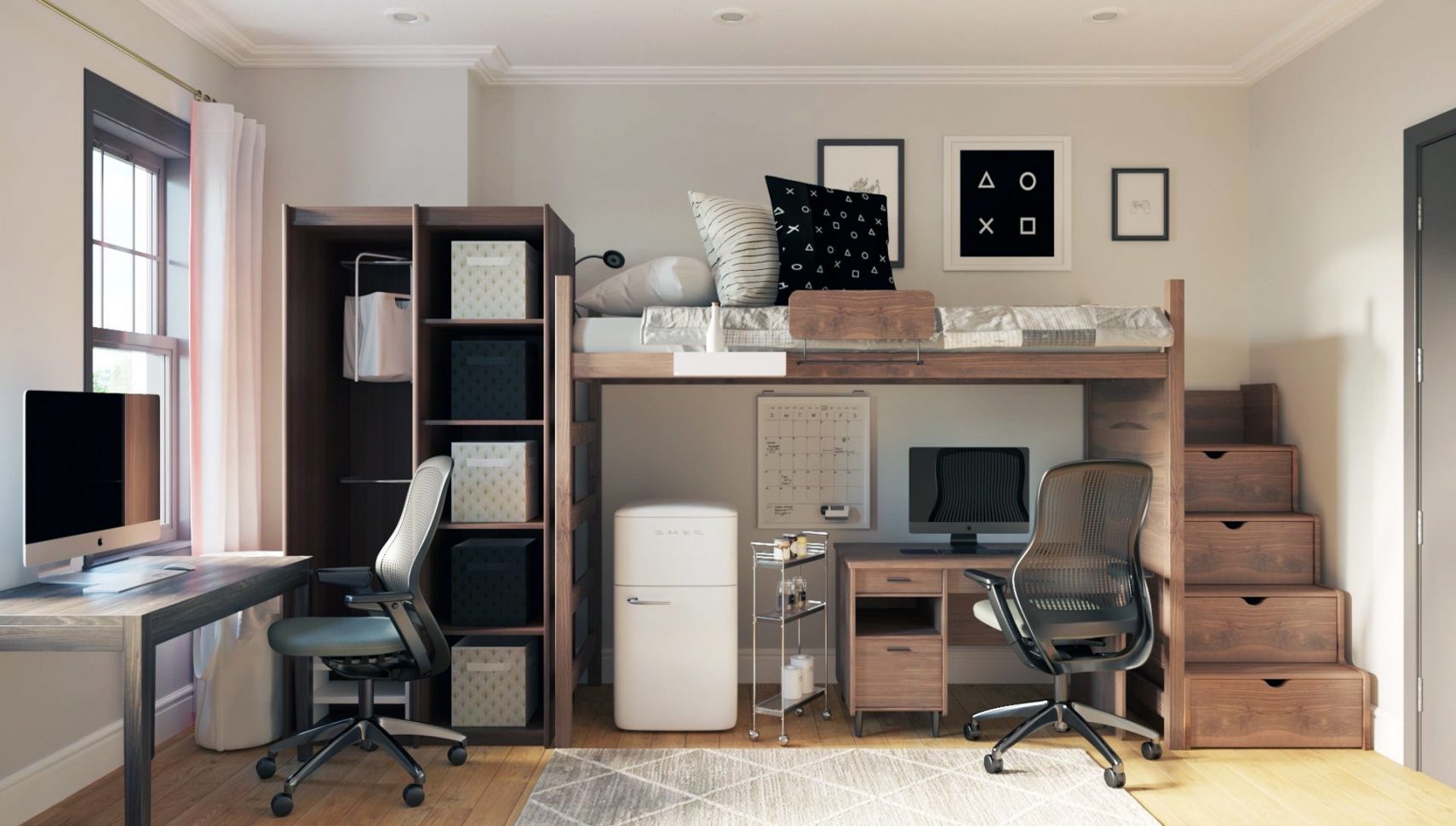As we move into August, college kids everywhere are preparing to move back into dorm life, pandemic-willing (an exhausting theme of late). Since it’s common knowledge that dorm rooms aren’t always the most chic living spaces—from cinder block walls to bean bag chairs—we want to assure you that it is indeed possible to make your dorm room feel both comfortable and stylish.
While experts in design today, our lead designers confess that their college dorm rooms were far from in vogue. Sound familiar? Luckily for you (or your kiddo), hindsight truly is 20/20, and we’ve put together a list of dorm decor ideas they really wish they knew about when they were in college. Read on for pro tips to create the best-looking dorm on campus (or coolest collegiate makeover at your folks’ place, cause who knows what 2021 will bring).

1. Break Color Rules
For starters, try not to get caught up in a matchy-matchy or predictable color scheme—all one specific accent or everything in school colors (just no). Rather, go with whatever colors and palettes speak to you and convey your style. It’s easy to fall into the “shoulds” of styling, but our designers emphasize the importance of making your dorm space “definitely you.” If you love neutrals, use them and add texture for warmth and coziness; if you love color, create a vibrant palette with your favorites. Or if you’re not sure? We got you, too. Check out these trending palettes for all the color inspo we’re crushing.
Don’t focus too much on lights and darks and how they impact the size of the room—incorporating both can benefit the space. You might have learned that light colors in smaller spaces make a room seem bigger, but dark colors can have the same effect by creating the illusion of depth. So if black is your favorite color, here’s your invitation to go for it when styling your dorm room! And know that a healthy mix of light and dark hues can create some tonal magic.
Havenly designer pro tip: Playing with opposites—light and dark colors, soft and rough textures—creates contrast, and contrast makes spaces feel more interesting and dynamic.
If you’re struggling to decide and need guidance, consider color psychology and how particular colors impact the mood of a room. Or if you’re more of a rule-follower, keep the oldest interior design rule in mind: Choose a dominant color to encompass 60% of the room, a secondary color for 30% of the room, and an accent color for 10% of the room.
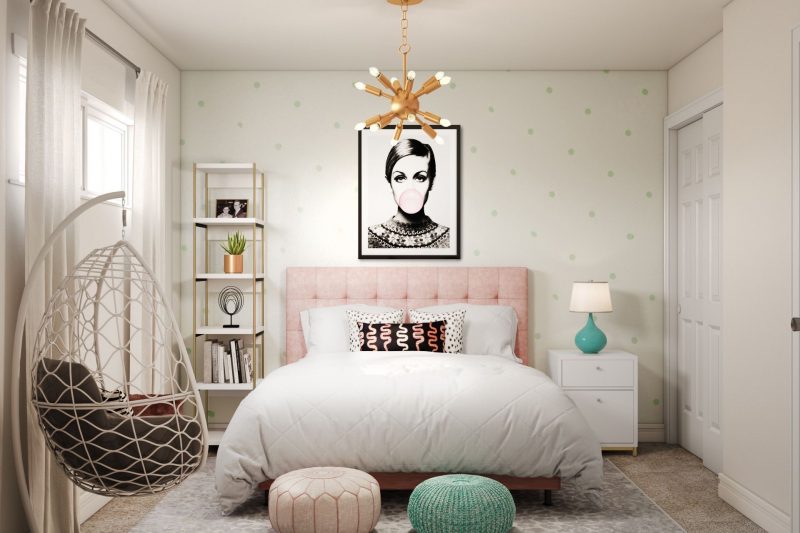
2. Mix and Match Styles
Dorm rooms, among other things, are essentially blank canvases for you to mix, match, and experiment with styles and décor that you love. You shouldn’t feel compelled to commit to one design aesthetic! Our designers all agree that mixing design styles is one of the best ways to create a room that’s appealing. Don’t be afraid to combine preppy patterns with a bohemian-style chair, mid-century lighting, and glam wall décor.
But there’s one thing to keep in mind when throwing a ton of different styles into a small space and avoiding chaos: use that color palette we talked about to create cohesion and tie everything together.
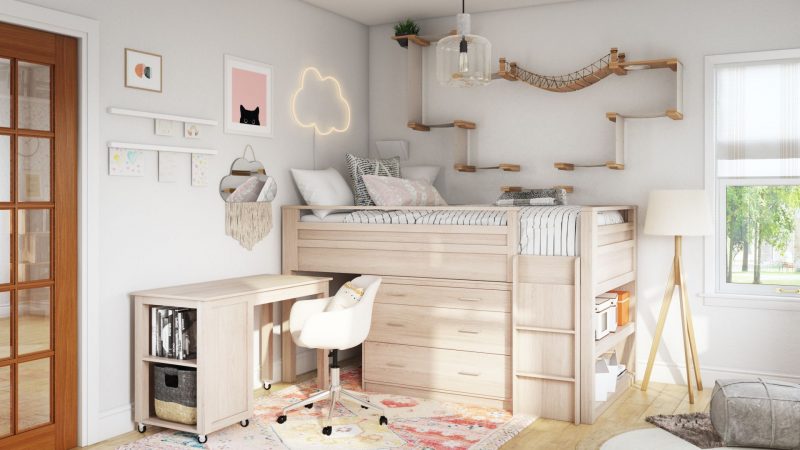
3. Go Vertical for More Space
Layout is also a big part of both maximizing space and creating a dynamic room. Dorm rooms aren’t typically spacious, so it’s important to be mindful of both style and livability. Our designers say optimism is key when it comes to figuring out where to put what in your dorm room. By maintaining a glass-is-half-full mindset, you’re more likely to identify creative, space-planning opportunities that will make the most out of your dorm room. You also don’t necessarily have to live with the furniture arrangement originally given to you—consider lofting your bed (safely and if allowed by the university) and placing your desk or dresser underneath it to create room for extra lounge and hobby space. If bunking is an option, consider that too. It’s all about maximizing vertical space in a dorm room.
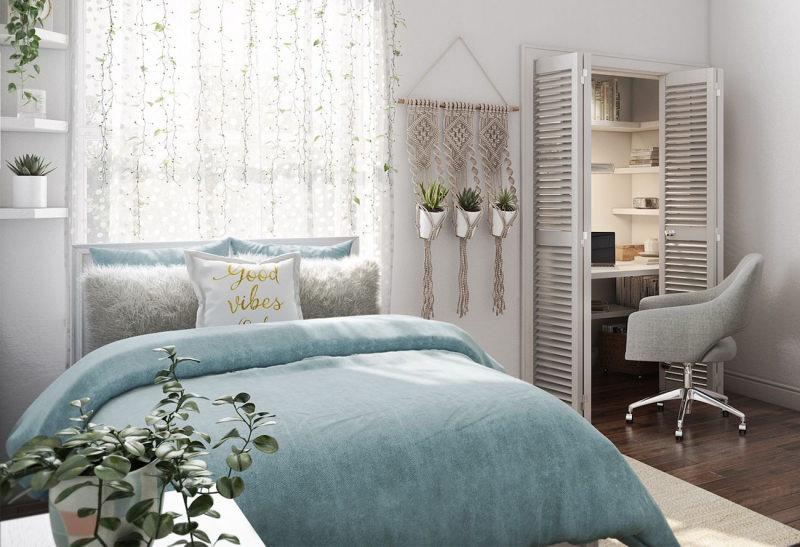
4. Explore Hidden Potential
To maximize your dorm room’s full potential, you must identify areas of opportunity—either underutilized or misused space around the room—and determine how to reuse it in a way that aligns with your functional needs. Ask yourself questions like, do you need storage for books and have at least one window? Use the window as a makeshift bookshelf, stacking books either vertically or horizontally along the sill. Do you have more closet space than you need? Consider opting for a clothing rack and turning the closet into a study area instead. Maybe the reverse is true and you have limited closet space (and you can’t loft your bed). Look underneath and use free space to store away seasonal or recreational items.
Pro tip: Buy bed risers to expand under-the-bed space.
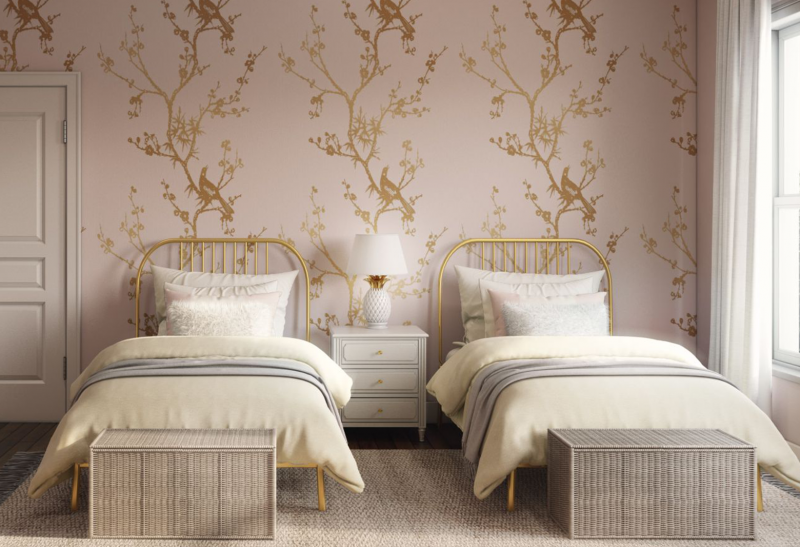
5. Multifunctional Pieces Are Your Dorm Room BFF
The same mindset is useful when deciding what to purchase for your space. On one hand, you have a world of useful products to choose from, but on the other hand, budgets are real. Try to keep an eye out for multifunctional products that offer both style and purpose; in the world of dorm room decorating, the best products save money and floor space. A mirror with built-in storage components gives you a designated area for concealing personal items like jewelry or sunglasses. A low-lying dresser serves the additional function of a bench if you top it off with a few pillows or a bench cushion. An ottoman with storage inside offers a place for extra bedding or school supplies while giving you extra seating for guests and a spot to kick up your feet.
Pro tip: Place two ottomans side-by-side or a bench at the foot of the bed for a finished, put-together look that reads “adulting.”
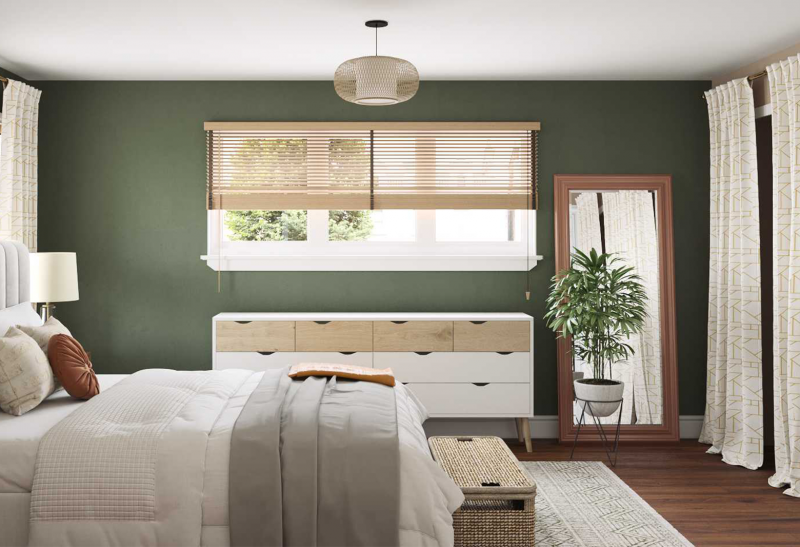
6. Layer In Softness with Textiles
Let’s face it, most college dorm rooms are pretty harsh and sterile. Generic boxlike settings with nondescript walls and stark features. How to counter? Bring in all the textiles. We’re talking rugs, pillows, poufs, throw blankets, and most definitely, curtains. The temptation can be to overlook these pieces in lieu of storage or functional needs, but we promise, these elements weave in texture and a much needed softness. Making a dorm room more cozy, comfy, and inviting.
Pro tip: Consider covering ugly closet doors with curtains for an instant makeover. Speaking of, check out our favorite design-approved budget-friendly curtains.
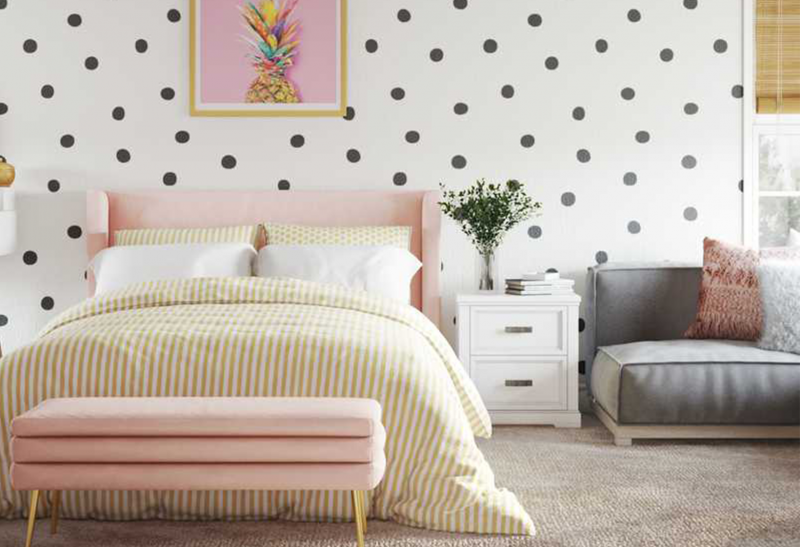
7. Dress Up Your Walls
Another antidote to general blandness: wallpaper. We know what you’re thinking… a) that sounds difficult, b) that sounds permanent, and c) no way the dorm authorities-that-be are going to allow it. But we’re talking removable peel-and-stick options that are (minimal) fuss and muss, and can be removed at the end of the year without damage. Over to you on whether you’re more of an ask permission or ask forgiveness type (though, we recommend checking in first). If you’re ready to take the leap, this is a great way to completely transform a dull dorm room into a show-stopping space.
We even introduced our very own wallpaper line of exclusive, on-trend prints in every style to make your selection a breeze.
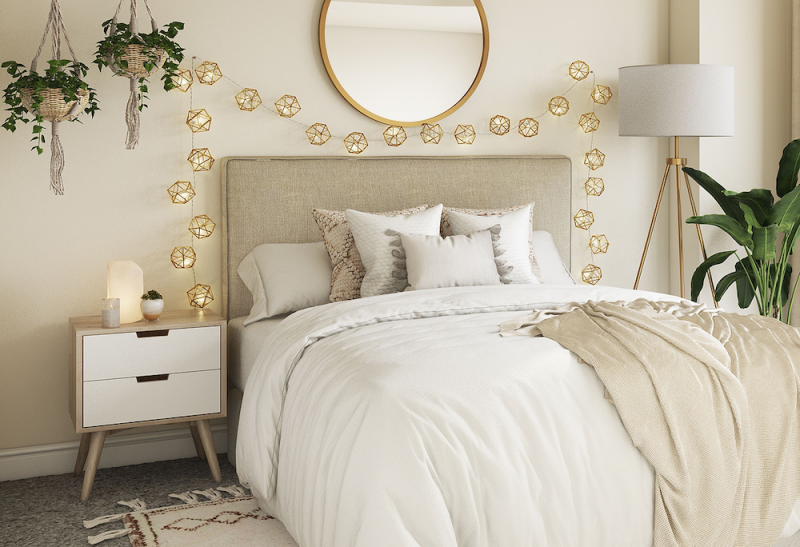
8. Lighting is Key for a Dorm Glow-Up
While the collegiate experience is truly an immersive experience, let’s face it, studies are a critical component. And sufficient desk lighting (think: adjustable task lamps with bright lighting) is a must. That said, you should also look to incorporate table, floor, and hanging lights and make sure not to obstruct any natural light.
Lighting affects emotions, mood and mental health—not just yours, but anyone you hang out with—and it also affects quality of sleep, which in turn affects your general wellness. Make sure you have multiple options with varying levels of brightness to accommodate wellness needs or adjust to bring the right ambience to the room. You’ll thank yourself later for creating sunlit power hours during the day, and cozy dorm-room vibes for late nights writing papers.

9. Express Yourself Through Artwork
College is about letting your best self shine: through accomplished work, long-lasting friendships, and self-expression. As any parent remembers, these are the days you’re really learning who you are and what makes you tick. What better way to do that than with your favorite artwork placed around the room? Artwork is a crucial finishing touch that not only brings completeness to a space, but also an element of character and personality.
Showcasing artwork is basically a form of storytelling that has the power to inspire and connect with the observer (hello, new friends passing by in the hall). Whether abstract pieces make your artistic heart beat, travel is your passion and you can’t wait to fill your passport, or you find yourself drawn to a life with whimsy and charm, embrace pieces that resonate deeply with you. Meaning: avoid ubiquitous ‘live, laugh, love’ word art—unless that’s your personal mantra, then you do you. Whatever you love, whatever your faves, let your guard down and show off a bit of your personality on your walls.

